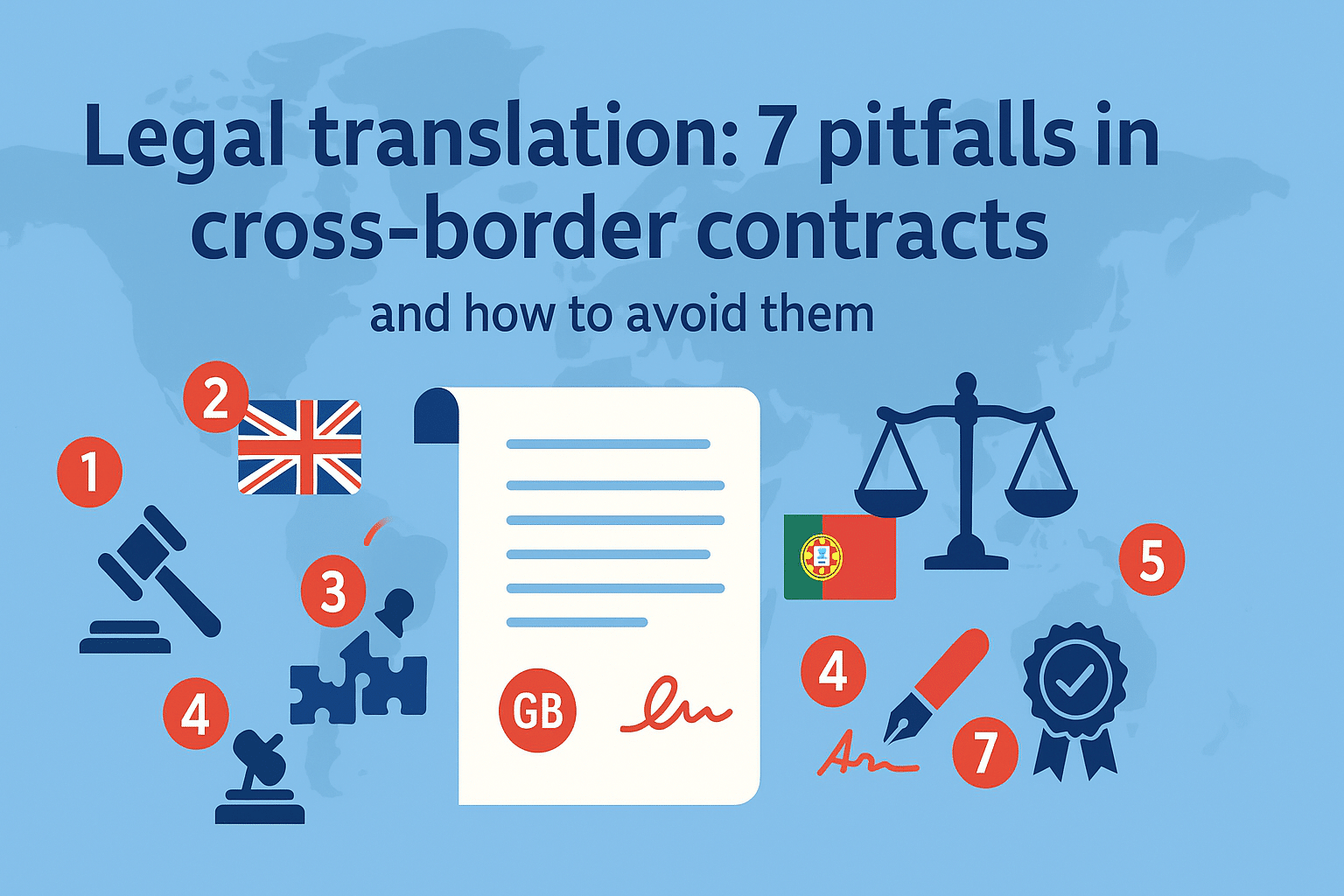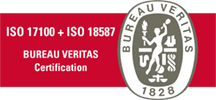Legal translation: 7 pitfalls in cross-border contracts
Legal translation can make or break cross-border contracts. Here are 7 pitfalls that derail deals—and practical ways to avoid them.

Table of Contents
Why this matters
When contracts travel, meanings shift. A clause that is harmless in London can become explosive in Lisbon or São Paulo if legal translation misses how a local court will actually read it. Below are seven failure points we see when reviewing bilingual MSAs, NDAs, SOWs and SPAs—plus fixes you can apply on your next deal with a vetted translation company operating under ISO workflows.
Pitfall 1 — “Governing law” and jurisdiction don’t survive translation
The most negotiated lines are often the first to fail across languages. A literal rendering of “exclusive jurisdiction” or “submission to the courts of…” may weaken or even invert enforceability when read by a different court.
Fix: lock terminology with a glossary and a back-translation step. Choose a provider that pairs legal linguists with attorney reviewers—see how our legal translation workstream staffs multi-jurisdiction projects and coordinates reviewers across time zones. Keep your brand counsel looped in and publish a style guide via your central translation services hub.
Pitfall 2 — Definitions and schedules drift away from the body
Definitions, annexes and incorporated policies are where scope creep hides. If a defined term like “Confidential Information” is translated differently in the body, the annex, and the DPA, you’ve created ambiguity.
Fix: translate definitions first, then propagate via CAT termbases. Maintain a single source of truth and roll changes through all annexes. For complex exhibits, route content to specialists—e.g., engineering specs to technical translation and pricing schedules to financial translation.
Legal translation and risk allocation in commercial clauses
Payment terms, warranties, limitations, and liquidated damages live or die by nuance. A misplaced modal (“shall” vs. “may”) or an over-broad warranty verb can push risk to the wrong side.
Fix: for business-critical clauses, run a bilingual legal review that laser-focuses on (1) modals and verb force, (2) qualifiers (“material”, “reasonable”), (3) carve-outs and exceptions. Where the agreement touches operations, align with business translation so IP, HR and compliance wording mirrors local practice without upsetting negotiated intent. When you need stakeholder buy-in fast, share published answers from our FAQ and recent client outcomes in testimonials to reduce friction.
Pitfall 3 — Certification and apostille requirements are unclear
Many cross-border deals later need certified copies for regulators, notaries or courts. Misunderstanding when you need a certified translation versus a notarised statement or apostille causes rejected filings and missed deadlines.
Fix: plan certification paths upfront and align to destination requirements. Start with official guidance from the Hague Apostille Convention and EU conflict-of-law rules (Rome I). When certification is required, book it through certified translations and reserve time for stamping and any in-country formalities. For urgent matters, jump straight to Request a Quote.
Pitfall 4 — Data protection, IP and local employment terms aren’t localised
DPAs, licensing and employment covenants often need local flavour: references to national data authorities, moral rights, or union rules don’t port 1:1.
Fix: localise to the target jurisdiction, not just the language. Build bilingual matrices mapping clause packs by country and call out non-portable terms. For commercial docs, our business translation team aligns IP and HR wording to local practice while preserving your negotiated position. If your operations span PT, ES and FR, sequence review with native legal linguists in your working pairs.
Pitfall 5 — Ambiguous numbers, dates and decimals
Comma/decimal conventions (1.000 vs 1,000) and date formats (02/03/2025) are classic dispute magnets.
Fix: enforce ISO-style number formats in exhibits and spell out critical figures (“one million (1,000,000)”). Lock formatting rules in your style guide and ensure your legal translation team applies them consistently across schedules and purchase forms.
Legal translation in regulated and scientific annexes
Technical appendices (clinical, safety, testing) sit under regulatory regimes. If your contract references these by incorporation, their legal translation quality must match the main agreement—regulators won’t care that it was “only an annex.”
Fix: route scientific and medical annexes to qualified linguists using validated termbases—our scientific translation process covers clinical terminology, abbreviations and QC, with mirrored pagination to keep citations and clause references aligned.
Pitfall 6 — Signatures, stamps and page integrity
If bilingual versions are not page-locked, stakeholders sign mismatched versions. Missing stamp attestations and mis-bound annexes are common rejection reasons.
Fix: finalise bilingual packs as mirrored PDFs with page numbers and cross-references. Where required, add certification and apostille steps (see Pitfall 3). To compress lead time, assemble a filing-ready bundle and coordinate courier steps via Contact us, or go straight to an urgent quote request.
Pitfall 7 — No single source of truth across languages
Parties sign “English prevails,” then work operationally in Spanish or Portuguese. Teams implement the wrong version.
Fix: designate a master language and maintain a controlled bilingual reference. Keep change logs in both languages and circulate a single signed PDF package. If your day-to-day runs in PT↔EN or ES↔EN, align with native legal linguists in those pairs: see Translations from Portuguese to English and Spanish to English translations. For broader combinations, explore translation from English to Portuguese, Portuguese to Spanish and Portuguese to French.
Practical checklist (copy/paste)
- Define governing law & forum; validate wording in both languages using your legal translation glossary.
- Build a bilingual definitions set and lock it in your translation services termbase.
- Decide certification/apostille path before signing, guided by the Hague framework.
- Route technical annexes to technical, financial or scientific teams as needed.
- Standardise numbers, dates, decimals; spell out critical figures.
- Produce mirrored, page-locked bilingual PDFs; coordinate stamping via certified translations.
- Nominate a master language; maintain bilingual change logs; socialise answers via FAQ and reassure stakeholders with testimonials.
- Kick off with Request a Quote or meet the team at M21Global.
FAQ
Q1. Do I need certified legal translation for cross-border contracts?
Not always. Certification is generally required when a public authority, court, notary or registrar will rely on the translated document—think corporate filings, court submissions, or certain M&A approvals. In these cases, the translation must be accompanied by an attestation identifying the translator and asserting fidelity to the source, sometimes notarised, and—if the destination country is party to the Hague Convention—possibly with an apostille attached to the signature.
For purely commercial purposes between private parties (e.g., vendor contracts that will never be submitted to authorities), certification is often optional, provided both parties agree on the bilingual pack and the “prevailing language” clause. When in doubt, confirm with local counsel and plan the path early to avoid last-minute scrambles; if needed, arrange it via certified translations after checking the Apostille requirements.
Q2. Which parts of a contract are most error-prone in legal translation?
Definitions sections, limitation of liability, indemnity carve-outs, IP ownership, data protection clauses and payment mechanics are usual suspects. These combine dense terminology with high commercial impact, so even small shifts (“will” vs “shall”, “may” vs “must”) change obligations. Add local legal concepts that don’t map one-to-one—like “good faith” standards or moral rights—and you have a recipe for ambiguity. The cure is workflow, not heroics: build a bilingual glossary first; translate definitions before the body; assign legal-specialised linguists; and require second-linguist revision under ISO 17100. For annexes (technical or financial), route them to the right vertical teams—technical translation or financial translation—so term choices stay consistent across exhibits.
Q3. How do I keep two language versions “equally authoritative”?
Start by stating that both versions are equally authentic—or, if you prefer operational simplicity, nominate one “prevailing language” while treating the other as a working translation. In either case, create a mirrored layout: same pagination, headings and clause numbering in both languages. Maintain a change log that records edits in both language versions, and circulate a single PDF bundle for signature to avoid mixed-version signatures. For ongoing operations, agree internally which version your teams will work from (e.g., Portuguese for local teams) and require that SOPs quote the same wording as the signed bilingual pack. A seasoned translation company can host this as your “single source of truth.”
Q4. What’s a practical timeline for a 50-page bilingual pack?
Timelines depend on complexity, domain (tech, finance, life sciences), revision model (ISO 17100 requires two linguists), and whether certification/apostille is needed. A pragmatic approach is to stage delivery: (1) glossary + definitions; (2) business body; (3) technical annexes; (4) bilingual legal review; (5) certification and apostille (if required). With the right resourcing, legal and technical streams run in parallel. If you’re working toward a regulator or notary date, factor in buffer for stamping and any in-country formalities. For urgent cases, start with an online quote and confirm the critical path in writing.

